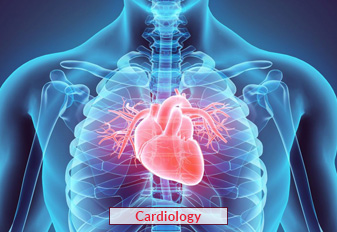Cardiology
Cardiology is a medical specialty that focuses on identifying and treating problems of the heart and circulatory system. In addition to conducting tests, the cardiologist may do procedures such as pacemaker insertion, angioplasty, and cardiac catheterization. It deals with heart-related diseases ranging from birth abnormalities to acquired cardiac ailments such congestive heart failure and coronary artery disease.
About
Heart disease is unique to the heart, whereas cardiovascular illness involves the heart, blood vessels, or both. Cardiology has several subspecialties, including nuclear cardiology, cardiac electrophysiology, interventional cardiology, and echocardiography. Numerous heart problems, including hypertension, pericarditis, ventricular tachycardia, congenital heart disease, coronary heart disease, congestive heart disease, arrhythmias, hypertension, high blood pressure, and triglycerides and many others. A cardiologist will evaluate the patient physically and review their medical history. Along with certain tests, they may check the patient’s blood pressure, heart rate, lung capacity, weight, and blood vessels. An interventional cardiologist can conduct procedures such as coronary thrombectomy, valvuloplasties, stenting, angioplasties, and congenital heart defect repairs.

Cardiology encompasses a variety of procedures. Some of the primary processes are:
- · Cardiac catheterization: A tiny tube in or close to the heart gathers information and could be used to clear a blockage. It has the ability to acquire images and assess the electrical and cardiac systems’ functionality. Conditions of the heart, valves, and coronary arteries that are congenital can be treated with catheter-based methods and fluoroscopy.
- · Biventricular pacing – also known as cardiac resynchronization treatment, uses a pacemaker to assist the left and right ventricles work in harmony, improving the heart’s overall output capability.
- · Angioplasty & Stent Placement: A cardiac surgery called coronary angioplasty helps to unclog heart arteries. A tiny balloon catheter is inserted through the restricted artery by the doctor to release it.
- · Rotational atherectomy: During the treatment, a tiny revolving blade is used to widen an artery and allow blood to flow back to the heart. To keep the artery open and stop it from narrowing again, a tiny mesh tube known as a stent is frequently placed inside of it.
- · Cardiovascular magnetic resonance – A heart transplant involves surgery to remove a patient’s damaged heart and replace it with a healthy donor heart. An intricate picture of the heart can be obtained via magnetic resonance imaging (MRI), which can be used to assess both the architecture and function of the heart. This aids in the diagnosis of particular illnesses, such as cardiomyopathies or conditions affecting the heart’s outer lining.
- · Heart Transplant Surgery– Heart-related magnetic resonance imaging An intricate picture of the heart can be obtained via magnetic resonance imaging (MRI), which can be used to assess both the architecture and function of the heart. This aids in the diagnosis of some illnesses, such as disorders of the heart’s outer lining or cardiomyopathies, or diseases affecting the heart muscle.
